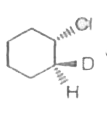In the following questions , a statement of assertion (A) is followed by a statement of reason (R). Br A : For every chemical reaction at equilibrium, the value of standard Gibbs free energy change is zero. R: At constant temperature and pressure for a reaction that direction is preferred for which Gibbs free energy increases.
If both Assertion & Reason are true and the reason is the correct explanation of the assertion, then mark (1).
If both Assertion & Reason are true but the reason is not the correct explanation of the assertion, then mark (2).
If Assertion is true statement but Reason is false, then mark (3).
If both Assertion and Reason are false statements, then mark (4).
To solve the question regarding the assertion (A) and reason (R), we will analyze both statements step by step.
Step 1: Analyze the Assertion (A)
Assertion (A): For every chemical reaction at equilibrium, the value of standard Gibbs free energy change is zero.
- Explanation: The assertion states that at equilibrium, the standard Gibbs free energy change (ΔG°) is zero. However, this is incorrect. At equilibrium, the change in Gibbs free energy (ΔG) for the reaction is zero, not the standard Gibbs free energy change (ΔG°). The standard Gibbs free energy change is a constant value that depends on the specific reaction and its conditions, and it does not necessarily equal zero at equilibrium.
Step 2: Analyze the Reason (R)
Reason (R): At constant temperature and pressure, for a reaction, the direction is preferred for which Gibbs free energy increases.
- Explanation: This statement is also incorrect. In thermodynamics, for a spontaneous reaction at constant temperature and pressure, the Gibbs free energy (ΔG) must decrease (ΔG < 0). If ΔG is positive (ΔG > 0), the reaction is non-spontaneous in the forward direction. Therefore, the preferred direction for a spontaneous reaction is where Gibbs free energy decreases, not increases.
Conclusion
Both the assertion and the reason are false statements. Therefore, the correct option is:
Option 4: Both assertion and reason are false statements.
---
Assertion (A): For every chemical reaction at equilibrium, the value of standard Gibbs free energy change is zero.
Reason (R): At constant temperature and pressure, for a reaction, the direction is preferred for which Gibbs free energy increases.
Both the assertion and the reason are false statements. Therefore, the correct option is:
Topper's Solved these Questions
Similar Questions
In the following questions, a statement of assertion (A) is followed by a statement of reason (R )
A : O2 is paramagnetic .
R : N2 is paramagnetic .
View SolutionAssertion (A): For every chemical reaction at equilibrium, standard Gibbs enegry of the reaction is zero.
Reason (R ) : At constant temperature and pressure chemical reactions are spontaneous in the direction of the decreasing Gibbs energy.
View Solution
Knowledge Check
In the following question, a statement of assertion is followed by a statement of reason, mark the correct choice.
Assertion: When Qc=Kc, reaction is at equilibrium.
Reason: At equilibrium, ΔG∘ is 0.Aboth assertion and reason are true and reason is the correct explanationn of assertionBboth assertionn and reason are true but reason is not the correct explanation of assertionCAssertionis true but reason is false.Dboth assertion and reason are false.
In the following questions , a statement of assertion (A) is followed by a statement of reason (R). Br A: Evolutionary biologists believe that mammals are most successful. R: They have ability to maintain a constant body temperature
View SolutionStatement -1: For every chmical reaction at equilibrium , standard Gidds energy of reaction is zero
Statement-2: At constant temperature and pressure , chemical reactions are spontaneious in the direction of decreasing gibbs energy.
View SolutionIn the following questions , a statement of assertion (A) is followed by a statement of reason (R). Br A: Epidermal hairs on the stem are called trichomes R: They help in absorption of water los due to transpiration,
View SolutionIn the following questions, a statement of assertion (A) is following by a statement of reason (R )
A: on reaction with alcoholic KOH gives
on reaction with alcoholic KOH gives 
R: Bond energy of C-D bond is less than of C-H bond.
View SolutionIn the following questions, a statement of assertion (A) is following by a statement of reason (R )
A : Chlorobenzene on reaction with sodium metal in the presence of dry ether gives diphenyl.
R: This reaction is called UIImann reaction.
View SolutionIn the following questions a statement of assertion (A) is followed by a statement of reason ( R).
A : At the highest point the velocity of projectile is zero .
R: At maximum height projectile comes to rest.
View SolutionIn the following question a statement of assertion (A) is followed by a statement of reason (R )
A: Absolute value of potential is not defined
R : Two equipotential lines cannot intersect each other.
View Solution
